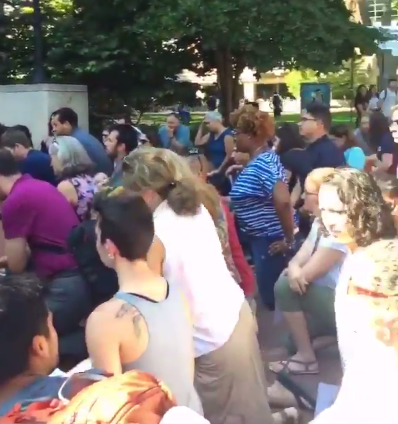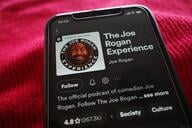You have /5 articles left.
Sign up for a free account or log in.

Scientists and others kneeling at the University of Michigan
Kenzo Esquivel
What started as a long-simmering debate about whether Colin Kaepernick is or is not being blackballed in the NFL for refusing to stand during the national anthem ignited into a four-alarm fire following President Trump’s decision to call for the firing of football players protesting police brutality.
As such, the public discussion concerning a former quarterback and pro sports has now encapsulated a much broader scope of issues on campuses, as faculty members have taken a knee in support of free speech protest and the attorney general, Jeff Sessions, has criticized American universities for becoming “an echo chamber of political correctness.”
This trip back to the social activism of the ’60s and ’70s has left many university administrators and faculty members without a playbook as we grapple with the need to address in rapid-fire succession a dizzying array of complex social issues that have had a significant impact on our academic communities and the students we educate.
One only has to click through the daily briefings from Inside Higher Ed to see that the issues of the “outside” world are impinging on the hallowed halls of academe at an increasing frequency: in response to Black Lives Matter, the presidential election, Charlottesville, DACA, Betsy DeVos and new OCR policies, among other issues, students are requesting, and sometimes demanding, that presidents and deans denounce the injustices of the world.
And to a large extent, so it should be: our institutions of higher learning are not isolated towers, ivory or otherwise; they are part of the real world, and our ability to educate is severely compromised if we do not address those concerns. Our leaders do have an obligation to make statements on the great ethical issues of our times. Their voices carry weight, they are heard by many.
And faculty members have those obligations, too -- and not just those teaching undergraduates. Certainly, we in medical schools fail in training physicians if we do not teach about health-care disparities alongside anatomy and physiology. Our medical case studies need to incorporate why ethnicity matters and how we define race -- not simply to add a tag line about a patient being African-American as if we are filling in a Mad Lib.
Yet both administrators and on-the-ground members of the faculty are finding it increasingly difficult to respond in an adequate fashion, much less with the kind of thorough thoughtfulness that such issues require.
Yes, students want us to take a stance on the issues they think matter, and they want it in a time frame that fits with the 24-hour cycle of media hyperbole. So administrators and faculty members struggle to know which issues merit a public pronouncement and which do not. Should we comment on racism at our fellow universities but not ethnic cleansing in Myanmar? We struggle not because the latter doesn’t matter, but because a constant string of 140-character tweets or micron-thin official website statements on all of the world’s wrongs strips them of meaning.
Outside earshot of their students, many faculty members (and likely more than a few senior administrators) may with exasperation whisper, “Can’t we just get back to teaching the things we know?” (What is apoptosis? What is the QT interval in a cardiac action potential?)
And the answer is no, we can’t step away, because there are DACA students midway through medical school who may be booted out of the country with no recourse to finish their training and a double whammy of tens if not hundreds of thousands of dollars of student debt. And there are my colleagues who don’t know if they feel safe to take their kids to the park in an area of the country consistently rated one of the best places to live in the United States because some older kids might put a rope around their necks if they happen to have the wrong color skin.
Ironically, in the shallowness of his tweets, perhaps Trump might have actually done this country a favor: He has uncivilly elevated a discussion that has sunk back to debates on whether or the Colts should pick up Kaepernick to what Kaepernick civilly wanted us to discuss in the first place. But taking a knee or holding up a Black Lives Matter sign at a street corner in an upscale town like Hanover, N.H., only goes so far.
We need to go beyond symbolic protests, and we certainly need to find a better way to grapple with these issues than through the press, email and social media. If we do not follow up with the difficult conversations as to why those things matter with those who most disagree, we devalue the very causes we purportedly support by a public, but shallow, act of “giving voice.”
And we need to do so off our devices. While some people argue otherwise, many agree that empathy is likely the greatest tool we have toward making connections and reannealing our social fabric that today’s society tears apart. But making those connections means we have to put down our iPhones and Androids and talk directly to one another.
No one size fits all for what each institution or school will want to do or can do, but efforts to enhance communication do not necessarily require a huge infusion of resources or ponderous institutional policy changes. At our medical school, we have standing lunches where the senior deans meet with students. And while these sessions can focus on practical issues like management of ECHO360 or changes in expectations for the Medical Student Performance Evaluation, they have been the forum for instigating changes within the medical school community to address these broader societal issues. Stemming from these initial conversations, we have developed initiatives that include:
- Booking reserved spaces for discussion with no set agenda to allow conversations on the most pressing issues of the day to flow freely without the administrative burden of defining topics and appropriate attendees.
- Identifying a rapid response contact team of senior administrators from the different parts of the school who can be contacted by anyone in the community to request that the institution consider an official or organized response to specific issues.
- Creating a student feedback site (through Qualtrics) that allows immediate, real-time and anonymous student feedback (both positive and negative) on issues of diversity and inclusion, which then prompts a meeting with a faculty member and one of our identified student representatives from the Office of Diversity, Inclusion and Community Engagement. These personal meetings allow students to directly inform a faculty member that they are appreciative of how material was presented or to have a thoughtful conversation about why students might have found a presentation disrespectful -- even if that was not the faculty member’s intent. This initiative can capture specific issues to be addressed with an immediacy that can be lost with end-of-class surveys and act to defuse potential problems before they grow out of proportion. It also highlights a key concept: the most creative solutions to the very issues that are problematic to our students can often come from the students themselves (as did the solution for addressing real-time feedback though a survey mechanism). We as educators talk about the importance of active learning in the classroom; we should recognize that these precepts hold for addressing the social issues that have impact on our schools and colleges, and then engage students in the solutions as much as we do in team-based learning exercises.
- Creating a group of students, staff and faculty members who will work in concert with the medical school’s standing diversity council to provide practical guidance on integrating issues of race, ethnicity, gender, socioeconomic status and other key social determinants of health in the curriculum. The goals of the group include creating a set of guidelines that faculty members can reference as they prepare course material and performing a review of all patient cases.
- Establishing sessions to discuss best practices based on information from our professional societies (for example, relevant satellite meetings of the Association of American Medical Colleges), feedback from our counterparts at other med schools and review of the health professions literature to find best practices and evidence for both curricular reform and personnel interactions.
In the university, as well as in sports, perhaps one of the best things all of us can do is to get off our knees and electronic soapboxes (recognizing the irony of stating this in an op-ed piece) and provide ways for our students and colleagues in our community to gather in small rooms and to voice opinions to one another, especially those who see the world through different lenses. It isn’t so much that we need to provide “safe” spaces, defined as the PC echo chamber that Sessions decries. But it seems that the most effective discussions about potentially divisive issues that touch on race, sex, religion, patriotism and power arise when we know each other well as individuals and can talk openly and outside of the public eye.
And it seems that those efforts would go a lot farther than all the broadcasts and public gestures and pronouncements to truly make our students, staff and faculty members feel welcomed, included and valued.




